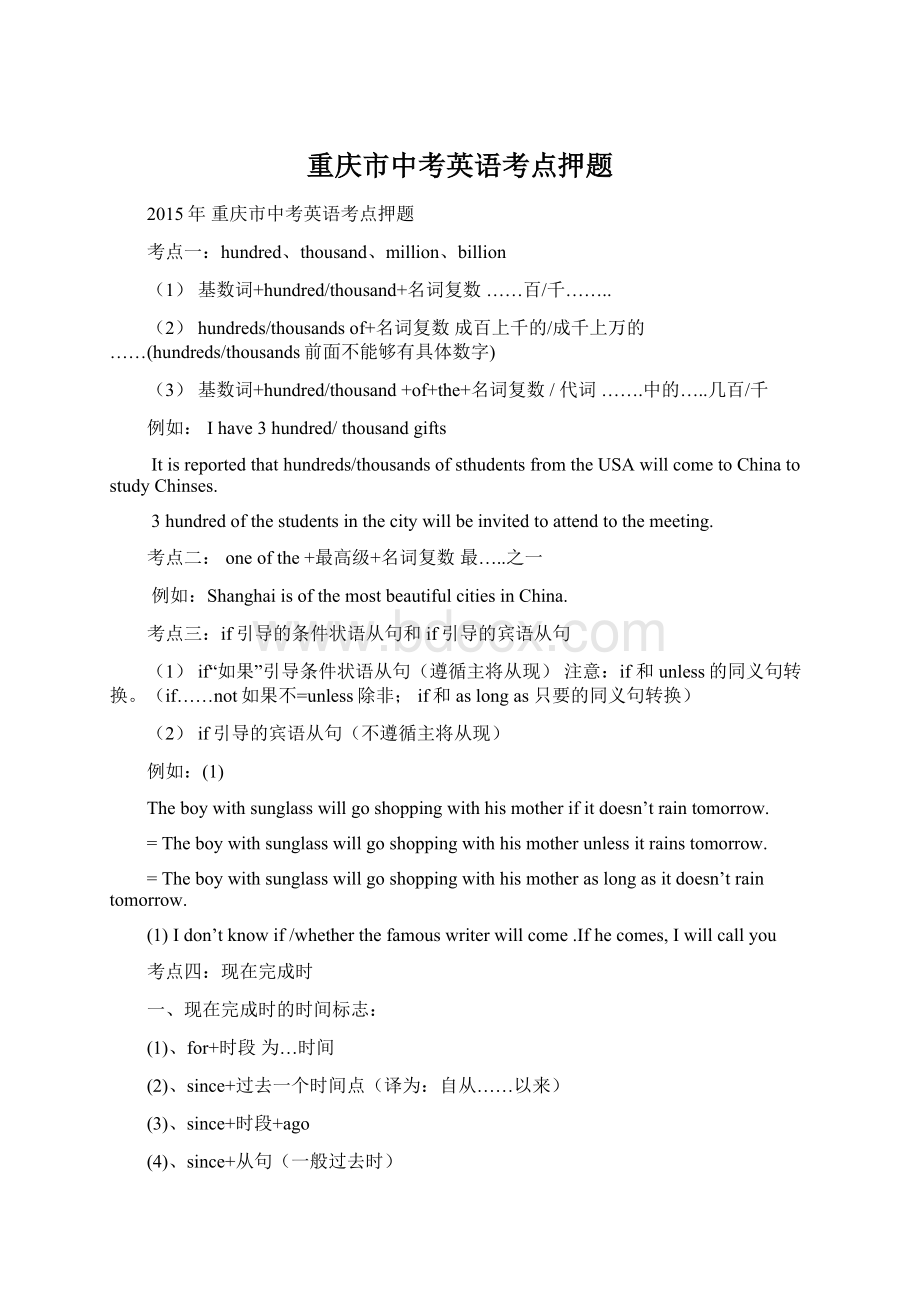重庆市中考英语考点押题.docx
《重庆市中考英语考点押题.docx》由会员分享,可在线阅读,更多相关《重庆市中考英语考点押题.docx(18页珍藏版)》请在冰豆网上搜索。

重庆市中考英语考点押题
2015年重庆市中考英语考点押题
考点一:
hundred、thousand、million、billion
(1)基数词+hundred/thousand+名词复数……百/千……..
(2)hundreds/thousandsof+名词复数成百上千的/成千上万的……(hundreds/thousands前面不能够有具体数字)
(3)基数词+hundred/thousand+of+the+名词复数/代词…….中的…..几百/千
例如:
Ihave3hundred/thousandgifts
Itisreportedthathundreds/thousandsofsthudentsfromtheUSAwillcometoChinatostudyChinses.
3hundredofthestudentsinthecitywillbeinvitedtoattendtothemeeting.
考点二:
oneofthe+最高级+名词复数最…..之一
例如:
ShanghaiisofthemostbeautifulcitiesinChina.
考点三:
if引导的条件状语从句和if引导的宾语从句
(1)if“如果”引导条件状语从句(遵循主将从现)注意:
if和unless的同义句转换。
(if……not如果不=unless除非;if和aslongas只要的同义句转换)
(2)if引导的宾语从句(不遵循主将从现)
例如:
(1)
Theboywithsunglasswillgoshoppingwithhismotherifitdoesn’traintomorrow.
=Theboywithsunglasswillgoshoppingwithhismotherunlessitrainstomorrow.
=Theboywithsunglasswillgoshoppingwithhismotheraslongasitdoesn’traintomorrow.
(1)Idon’tknowif/whetherthefamouswriterwillcome.Ifhecomes,Iwillcallyou
考点四:
现在完成时
一、现在完成时的时间标志:
(1)、for+时段为…时间
(2)、since+过去一个时间点(译为:
自从……以来)
(3)、since+时段+ago
(4)、since+从句(一般过去时)
(5)、以sofar(到目前为止)
(6)、inthelast/past+一段时间在过去的…里
(7)、以ever/never/just/already/yet为标志
(8)、以动作发生的次数为标志
(9)、fromthenon/sincethen自那以后
(10)、句子末尾以before为标志
二、have/hasbeento和have/hasgoneto的区别:
have/hasbeento去过某地(已经回来)
have/hasgoneto去了某地(未曾回来)
三、already和yet的区别
already(”已经”用于肯定句的中间和末尾处)
never(“从不”用于中间处)
ever(”曾经”用于疑问句和肯定句的中间处)
just(“刚刚”用于中间处)
yet(“已经”用于疑问句的末尾处/“还”用于否定句的末尾处)
四、瞬间性动词不可一段时间连用
瞬间动词(buy,die,join,come,go,leave,join……)不能直接与forsince连用。
要改变动词
buy----haveborrow-----keep
come/arrive/reach/getto-----beingoout----beout
leave----beawaybegin-----beon
finish----beoveropen----beopen
close-----becloseddie----bedead
常用瞬间动词变延续性动词表:
1.havearrivedat/insw.gotto/reachedsw.come/gone/movedtosw.
→havebeeninsw./at…相应的介词
2.havecome/goneback/returned→havebeenback
3.havecome/goneout→havebeenout
4.havebecome→havebeen
5.haveclosed/opened→havebeenclose/open
6.havegotup→havebeenup;
7.havedied→havebeendead;
8.haveleftsw.→havebeenawayfromsw.
9.havefallenasleep/gottosleep→havebeenasleep;
10.havefinished/ended/completed→havebeenover;
11.havemarried→havebeenmarried;
12.havestarted/beguntodosth.→havedonesth.;
13.havebegun→havebeenon
14.haveborrowed/bought→havekept/had
15.havelost→haven’thad
16.haveputon→haveworn
17.havecaught/getacold→havehadacold;
18.havegottoknow→haveknown
19.have/hasgoneto→havebeenin
20.havejoined/havetakenpartintheleague/theParty/thearmy
→havebeenamemberof/havebeenin/havebeentheParty’smember/theleaguemember/thesoldier…
考点五:
被动语态(一般现在时、一般将来时、一般过去式)
动词语态be+动词的过去分词
一、各种时态的被动语态
1、一般现在时:
am/is/are+过去分词
2、一般过去时:
was/were+过去分词
3、一般将来时:
willbe+过去分词
4、现在进行时:
am/is/are+being+过去分词
5、过去进行时:
was/were+being+过去分词
6、现在完成时:
have/hasbeen+过去分词
7、过去完成时:
hadbeen+过去分词
8、过去将来时:
wouldbe+过去分词
9、含有情态动词的被动语态
二、不适用被动语态的场合
1、不及物动词不用于被动语态。
Appear,disappear,rise,die,happen,occur,lie,depart,belongto,breakout,takeplace,reach,keepupwith,keepwords等不及物动词不能用于被动语态。
2、表状态动词不用于被动语态
常见的有:
hold,have,cost,contain,become,looklike,wear等
3、某些动词的进行时可表被动
4、主动形式表被动意义。
1)某些感官动词和系动词接形容词可以表示被动意义。
如:
look,smell,taste,feel,prove,wear,sound等
2)动名词的主动形式表示被动语态。
如:
want,deserve,need,require,take,worth等
3)某些作表语的形容词后,用不定式主动形式表示被动意义。
考点六:
MustI/we…..?
及作答
MustI/we…..?
及作答
Yes,……must.No,…..needn’t/don’thaveto.
考点七:
both、either、neither、all、each、every、none的区别
Neither两者任意一个都不,neither后接单数名词,动词用单数neitherof+n./代词+动词单数neither+A+norB“既不…..也不…..”谓语动词与B保持一致
Either两者中的任意一个后接单数名词,动词用单数eitherof+n./代词+谓语动词单数either+A+orB“或者…..或者”谓语动词与B保持一致
Both两者都bothof名词/代词+复数谓语动词bothAandB反义词neither
All三者或三者以上都allof+名词/代词+复数谓语动词反义词none
None三者或三者以上任一个都不noneof+名词/代词+单数/复数谓语动词
Every三者或三者以上中的每一个every+名词后面不可加of
Each两者或两者以上中的每一个eachof+名词/代词
考点八:
不定代词/不定副词+形容词
something/everything/nothing/anything/somebody/anybody/nobody/someone/everybody/somewhere/anywhere+adj.
somethinginteresting/important
考点九:
宾语从句
一、主句和从句的时态
(1)如果主句的谓语动词是一般现在时,从句的谓语动词可根据需要,选用相应的任何时态。
Idon’tthink(that)youareright.
Pleasetelluswhattheyboughtinthemallyesterday.
CanyoutellmehowIcangettotherailwaystation?
WeknowthattheywerestudyingEnglishatthattime.
WeknowthatshehasalreadybeentoEngland.
Ithinkshewillgoshoppingtomorrow.
Tomknowsthatthebushadleftwhenhecameout.
(2)如果主句的谓语动词是过去时,宾语从句的谓语动词只可根据需要,选用过去时态即一般过去时、过去进行时、过去将来时或过去完成时的某一种形式。
Heaskedwhattimeitwas.
Hetoldmethathewaspreparingforthesportsmeet.
HeaskedifyouhadwrittentoPeter.
HesaidthathewouldgobacktotheU.S.soon.
(3)如果宾语从句所表示的是客观事实、普遍真理、自然现象或习惯性动作等,不管主句用什么时态,从句时态都用一般现在时。
OurteachersaidthatJanuaryisthefirstmonthoftheyear.
Scientistshaveprovedthattheearthturnsaroundthesun.
Theteacherhastodusthatthelightgoesfasterthanthesound.
二、从句语序从句部分保持陈述语序
1.Noonecanbesure__________inamillionyears.
A.whatmanlookslikeB.whatwillmanlooklike
C.manwilllooklikewhatD.whatmanwilllooklike
2.Didyouhear__________?
A.whatdidIsayB.whatIsaidC.IsaidwhatD.whatIsay
3.Canyoutellme__________?
A.whichclassyouareinB.whichclassareyouin
C.youareinwhichclassD.areyouinwhichclass
考点十:
other、others、theother、theothers、another的区别
(1)other意为“另外,其他”作限定词(后接可数名词)无范围限制
(2)one…theother…….(两者中)一个……另一个……;theother+数词+名词复数
(3)another(三者或三者以上)另一个another+数词+名词复数=数字+more+名词复数再/还……
(4)others其他的一些,另外的一些无范围限制在句中单独使用结构为:
Some……others……一些……另外一些…..other+名词复数=others
(5)theothers其他的一些,另外的一些theother+名词复数=theothers
考点十一:
spend、take、pay、cost区别
(一)spend的用法
sb.spendtime/moneyonsth.某人花费时间/金钱在….上sb.spendtime/moneydoingsth.某人花费时间/金钱做某事
(二)pay的用法
Sb.paymoneyforsth.某人为….付钱buysth.formoney
Pay(sb.)moneyforsth.付钱(给某人)买某物
Payforsth.付某物的钱
Payforsb.替某人付钱
Paysb.付钱给某人
(三)take的用法
Ittook/takes/willtake…..(sb)timetodosth.做某事花费(某人)时间
(四)cost的用法
Sthcost(sb.)money某物花费(某人)金钱
【注意】
take和spend之间怎样相互转换?
Spend和cost/pay之间?
考点十二:
howlong/howfar/howsoon/howoften的区别
(1)howlong多长时间,对for/about+一段时间提问
(2)howfar多远对哦路程距离提问3kilometers30minutes’walk/drive/ride
(3)howsoon多久以后对in+一段时间提问(用于一般将来时态)
(4)howoften多久一次对表示频率的时间状语提问once/twice/3timesaday/week/month/year
考点十三:
put/give/turn/take/相关词组
一、put相关词组
putaway收拾;放妥;放弃
putoff推迟;延期
puton上演;穿上
put…into表达;翻译
putdown放下;写下;
putout扑灭;生产;出版
putup举起;竖起;张贴
putin放入
putback放回
二、give相关词组
getin到达,收集或收获;
getinaword插话
getinone’sway挡路;妨碍
getalong/on进行;进展;相处
getalong/onwith在……方面进展;与……相处/
getdown沮丧;吞咽;写下记下
getout泄露;出去;生产出版
getover克服
getup起床;站起
getout(of)出去(来);取出;避开;摆脱
getthrough做完;结束;通过;抵达
getaway(from)(从……)逃脱;摆脱;走开;(使)……离开
getinto进入;(使)陷入……状态
getacross使某事传播或为人理解
getto到达
getback回家,失而复得
getoff下车
geton上车
三、turn相关词组
turnto向……求助;翻到;转到
turnin上交
turnup出现;卷起;竖起;开大点(收音机等)
turnover移交;考虑;翻过;翻倒;打翻
turnon(off)开(关)
turndown驳回;拒绝;拒不采纳;拧小点(声音)
turnback折回;回转过来
turnagainst背叛;转而反对
turnout结果(是);生产;制造
turnaway拒绝让…进入
四、look相关词组
lookthrough浏览;翻阅;透过…看
lookup(vt.)查阅;(vi.)上涨;好转;抬头
lookupto尊敬
lookout(for)当心;注意
lookout(of)向……望
look(up)on…as认为……是……
lookon旁观
lookdownupon轻视;看不起
lookinto调查
lookinon顺便拜访
lookback(on)回顾
lookafter照看;看管
lookforwardto盼望
looksb.upanddown上下打量
lookover检阅或检查某事
考点十四:
祈使句的回答
-----Don’tsmokehere.--Remembertobringyourhomeworktoschool.
----Sorry.Iwon’t.--Ok,Iwill.Noproblem.
考点十五:
主谓一致
考点一、就近原则
or,either…..or…..;notonly……butalso….;neither…..nor….;therebe
考点二、就前原则
with、togetherwith/aswellas/assoonas/but/except/alongwith/like
考点十六:
非谓语
一、接动词不定式(todo/dosth)
二、接动名词 (doingsth)
三、V.+doingadmit(承认)、avoid(避免)、finish、deny(否认)、enjoy、mind(介意)、keep、dislike、consider(认为)、practise、suggest(建议)、imagine、miss、appreciate+doing
四、V.+todo或者V.+doing
1.stoptodo/doing停下来做另一件事停止做某事
2.forgettodo/doing忘记做某事忘记做过某事
3.remembertodo/doing记住做某事记得做过某事
4.goontodo/doing继续做另一件事继续做某事
5.liketodo/doing喜欢做某事(临时、长期)
6.lovetodo/doing喜欢做某事(临时、长期)
7.prefertodo/doing更喜欢做某事(临时、长期)
8.hatetodo/doing讨厌做某事(临时、长期)
9.start/begintodo/doingsth.(开始做某事)
10.continuetodo/doing继续做某事
11.trytodo(设法做)trydoing(试着做)
12.can’thelptodo(不能帮助做)can’thelpdoing(情不自禁做)
五、既用不带to的动词不定式又用现在分词的句型:
用不带to的动词不定式强调动作的完成过程;用现在分词强调动作的进行状态。
1.hearsbdosth./doing听见某人做某事听见某人正在做某事
2.listensbdosth./doing听某人做某事听某人正在做某事
3.lookatsbdosth./doing看某人做某事看某人正在做某事
4.seesbdosth./doing看见某人做某事看见某人正在做某事
5.watchsbdosth./doing观察某人做某事观察某人正在做某事
6.noticesbdosth./doing注意到某人做某事注意到某人正在做某事
六、常接动词原形do的结构
使役动词:
have,make,let
感官动词:
look,sound,see,hear,notice,feel,taste,smell
情态动词:
can,maymust
coulddonothingbutdosth
hadbetterdosth/hadbetternotdosth最好做某事
wouldratherdosthAthandosthB宁愿做A不愿做B
whynotdosth=whydon'tyoudosth为什么不做
It'sbettertodoAthandoB做A比做B好
helpsbdosth帮助某人做某事
七、介词后+doing
八、to作介词的情况lookforwardtodoingsth期望做某事;preferdoingsth.todoingsth与…相比较更喜欢…;payattentiontodoing注意做某事;be/getusedtodoingsth.习惯于做某事;makeacontributionto为…做贡献
考点十七:
get/become/beusedtosth./doingsth.习惯于某事/做某事
beusedtodosth.被用来做某事
beusedfor(doing)sth.被用来(做)某事
usedtodosth.过去常